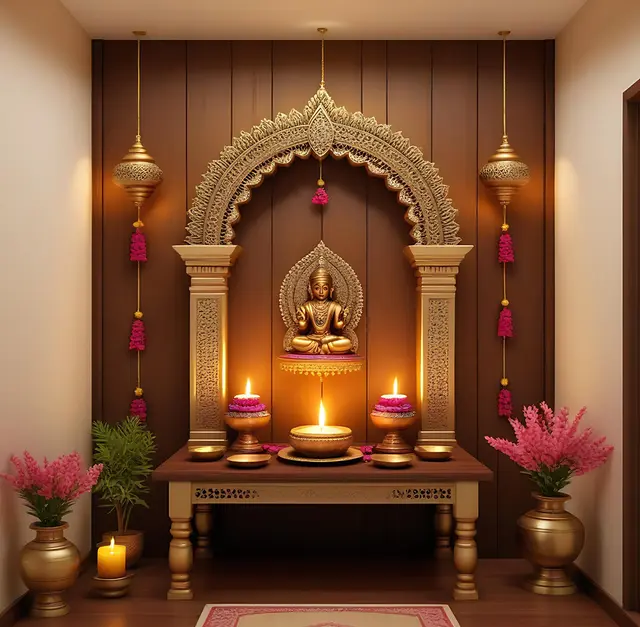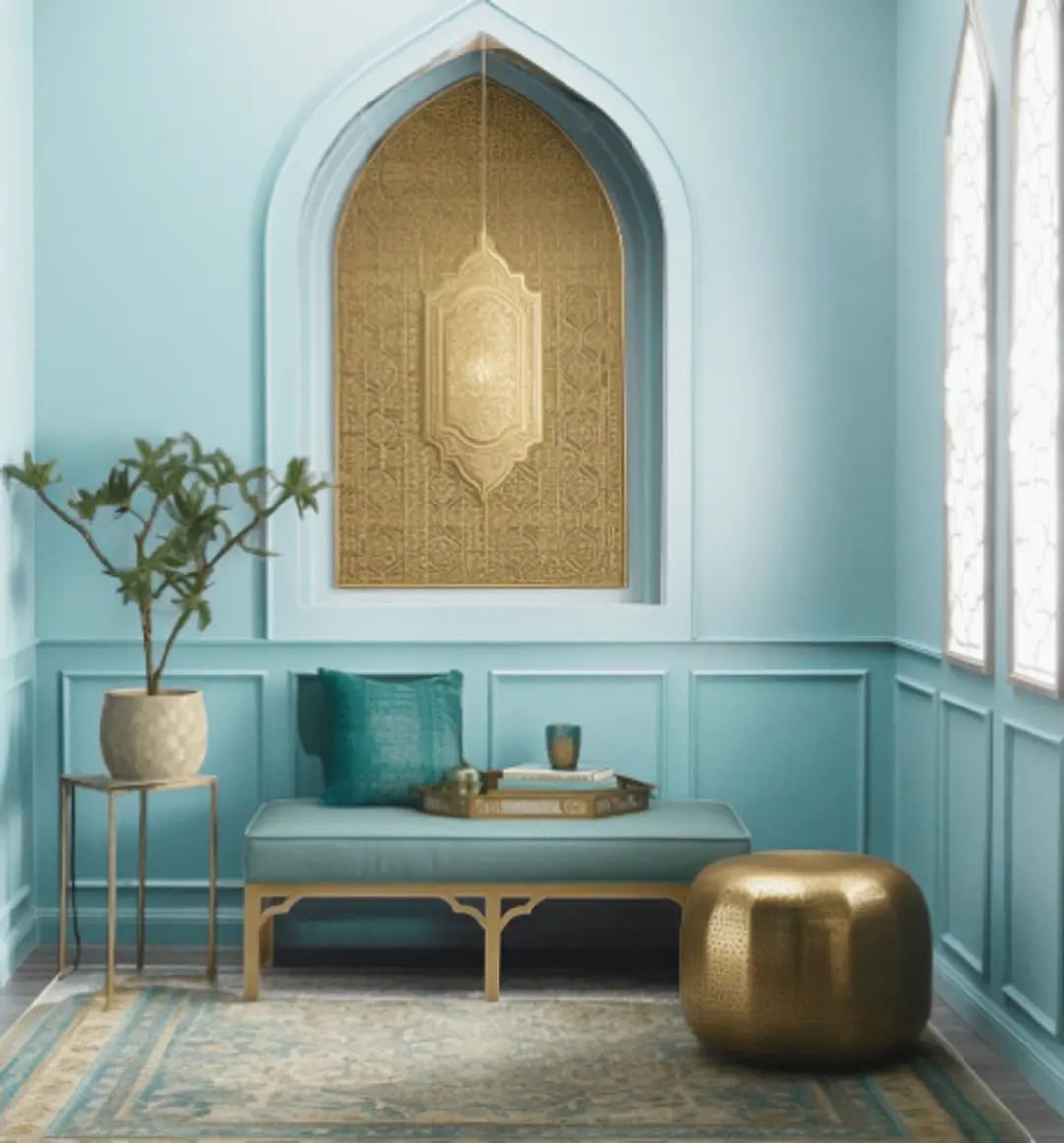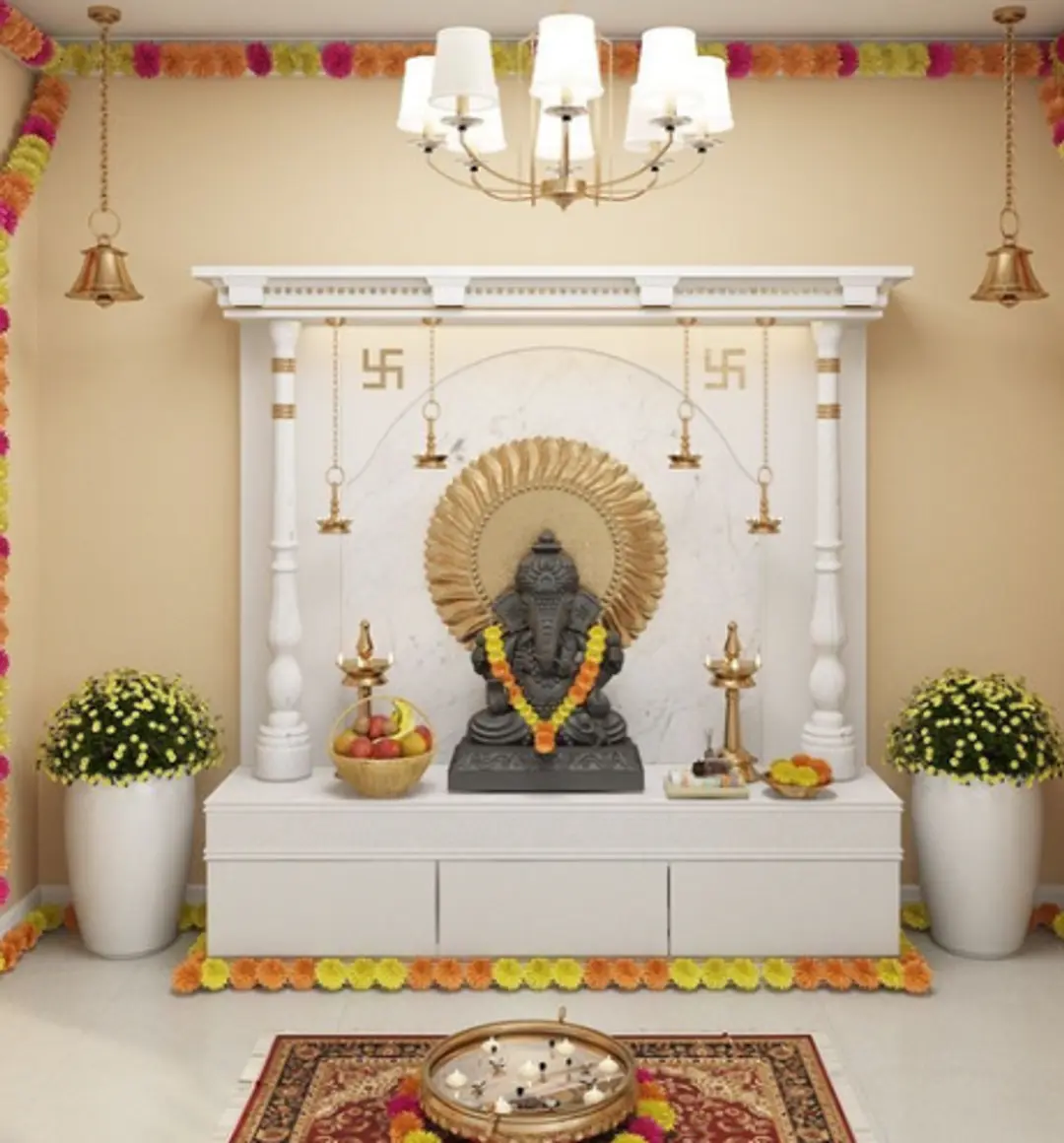Pooja Room Colours - Ideas and Inspiration
Room

Room
Pooja Room Colours - Ideas and Inspiration
Pooja Room Colours for Serene Experience!
Praying to the gods in a room that exudes positivity is, some say, just as important as the act of praying itself. But what if your pooja room colour doesn't make you feel positive on the inside? Then stop right there and think about how you can change your pooja room design to make you feel better. The change does not have to be big or expensive. Let's look at different ways to incorporate the most positive pooja room colours like 'Mermaid'S Song', 'Glorious Glow' and more according to vastu.
Best Colour For Best Colour For Prayer Room
Glorious Glow
 4T2099
4T2099Mermaid'S Song
 5T2247
5T2247Mojave Sand
 7T1595
7T1595Diamante
 8T1723
8T1723Shrimp Tint
 1D0322
1D0322Elemint
 4P0093
4P0093
Colour Inspirations

Blue Elegance
Paint your walls in a calming shade of blue, with ornate gold details adding elegance and tranquillity.

Sacred Space
Infuse your prayer room with an aura of reverence, fostering solace and inner peace within its sacred ambiance

Spiritual Haven
Transport yourself to a tranquil world of spirituality and serenity by decorating your walls with a subtle yellow shade.
Pooja Room Colours
Praying to the gods in a room that exudes positivity is, some say, just as important as the act of praying itself. But what if your pooja room colour doesn't make you feel positive on the inside? Then stop right there and think about how you can change your pooja room design to make you feel better. Let's look at different ways to incorporate the most positive pooja room colour according to Vastu.
Colours According To Pooja Room Designs
There isn't a one-size-fits-all solution when it comes to the best colour for a pooja room or even the most suitable pooja room colour as per Vastu.
Texture paint for Pooja Room
The first of many ways to create a pooja room as per vastu is with the help of texture paint for pooja room. Texture paint is a type of paint that adds depth and patterns to walls, and it can create effects like a rough, stone-like surface or an elegant marble look.
Texture paint for the pooja room is applied directly to the wall, creating a permanent design, whereas wallpaper is a removable layer that can be peeled off. Also, wallpaper usually has printed patterns while texture paint adds a 3D effect that you can feel to the touch of your hand.
Here are a few pooja room design ideas for using texture paint in creative ways:
- Rustic yellow colour for pooja room: Shades of yellow in a rustic texture will give the pooja ghar a more authentic feel like it is a small hillside temple room.
- Elegant Marble pooja room colour idea: For those who want to match the vibe of the house with the pooja room design, the marble texture finish is a suitable idea.
- Vintage pooja room colour as per vastu: If you're looking to create a quaint, old-school pooja room, the vintage wall texture is your solution.
Modern Colours for Pooja Room
When you want to take a different path and choose a more modern aesthetic for your pooja room, you need to keep in mind that a few of the contemporary options wouldn't be suitable for a pooja room colour as per vastu. With that being said, let's take a look at some of the modern pooja room wall colour options:
Shades of Grey: Grey is one colour that is all the rage today. You can go for any of the lighter shades as your colour for the pooja room, but ones like charcoal grey should be avoided.
Pastel Shades: Another one of the trends is pastel shades of the colours we all love, which are pink, blue, green, and yellow colour for the pooja room.
Pooja Room Colour Combinations
Let's look at the best balance of pooja room colour according to vastu and aesthetics:
- For Smaller Pooja Rooms: These are the ones where you should go for a light paint colour for the pooja room. This could be a wall colour combination of a pastel shade with beige.
- For Pooja Rooms in an Open Layout: In an open layout where the pooja room would be a part of a larger floor plan, you can go for a slightly darker pooja room colour idea. Keep in mind, however, that a very dark colour like black or navy blue isn't suitable for a pooja room colour as per vastu.
Pooja Room Colour as Per Vastu
Bright Colour Pooja Room Schemes
To make the place feel naturally happy, go for a bright pooja room colour. Your bright colour for the pooja room can be anything from sunshine yellow to a glistening orange. Painting the pooja room wall colour in such shades is a good idea if the overall decor of the house has similar colour schemes in certain areas.
Accent Colour Scheme
An accent colour scheme is nothing but one pooja room wall colour being strikingly different from all the others. This is a good combination if you want to add some colour to a neutral theme without going overboard.
In this, you can add a paint colour for the pooja room like lavender and apply beige or off-white on all the other walls.
Elegant Pooja Room Colour Scheme
An elegant pooja room colour scheme includes colours like grey paired with white, or beige paired with light brown. Basically, elegance is all about an understated vibe. If you want to add colours other than neutral shades, you can stick to lighter ones like pastel pink, blue, or yellow colour for the pooja room.
Traditional Pooja Room Colour Scheme
For those who would rather stick to the traditional pooja room colour scheme, colours like cream white and light brown are the most suitable options.
Frequently Asked Questions
The best colour for a pooja room is one that brings positivity, so what you need to do when selecting the pooja room colour for your house is see which colour makes you feel positive on the inside.
- Pastel Green and Beige: A pastel green colour for the pooja room is reminiscent of nature, and beige gives a visual break. As a colour combination for the pooja room design, they will make the room feel calm.
- Pastel Yellow and Light Brown: Pastel yellow colour for the pooja room is cheerful in a subtle way, and light brown is a neutral colour that makes for a good base.
- Red and Light Yellow: Red symbolises love and devotion, and when paired with light yellow, its energy feels balanced.
While most light shades make for a good pooja room colour as per vastu, there are a couple of options that rank higher than the others.
- Warm White: As you'd expect, warm white is the classic safe pooja room colour that ranks high when it comes to the best colour for a pooja room. Not only is it a good standalone colour but it also makes for a good backdrop for the idols and murtis you might bring into the pooja room.
- Light yellow: While we've covered the option of yellow colour for the pooja room, it is worth mentioning that being closest to white, this shade adds a pop of colour without straying too far away from the traditional white colour scheme.
The temple, or pooja room, is a special place for prayer, so you want the pooja room colour to feel peaceful. The paint you choose should also last a long time and be easy to clean.
Texture paint for the pooja room is a great option because it adds a soft look to the walls. Some paints also help keep the walls fresh by stopping fungus from growing, which is an important factor to keep in mind. You also want a temple that looks clean and inviting, so choose a paint that gives a smooth finish, especially in light shades like white, cream, or light yellow.
Colouring a home temple starts with picking the right pooja room colour. You want the temple to feel calm, so lighter shades of your favourite colour for the pooja room are better.
For example, a light yellow colour for the pooja room is very popular because it brings a lot of light and warmth into the room.
Now before you start painting the pooja room wall colour, you need to cover any existing furniture and temporarily move any murtis or idols if there are any already in place. Next, before you apply the pooja room colour, you need to do proper surface prep. This includes wiping down the walls to remove dust and applying a layer or two of primer.
Only after these steps are completed can you start with the actual painting process.
Start by painting the main walls in a light colour like white or cream. You can then add a special touch by using a different paint colour for the pooja room on one wall, maybe something like gold or soft maroon, to make it feel special. Another good idea is to add some texture paint for the pooja room, which can make the walls look rich without being too flashy.
If this process seems long and complicated, hire professionals from the Express Painting service to take care of the entire process from surface prep to colour selection, and beyond!
The right stone for the pooja room design is important in many aspects, including auspiciousness and practicality. Marble is a great choice for this because it looks elegant and expensive, and exudes positive vibes. It brings purity to the room, which makes it a favourite for many pooja rooms in India. Marble is also a strong stone, meaning it will last a long time, even with daily prayers taking place, and agarbattis being lit up on the surface.
But this is expensive and not the most affordable option, especially for those houses with larger or multiple pooja rooms.
In that sense, another good option is granite. Granite is a strong stone that is easy to clean and gives the pooja room a humble, grounded feel. Darker shades of granite, like black or dark grey, can provide a modern look, while a lighter granite colour for the pooja room makes the room feel bigger and brighter. Granite, despite the colour, is easy to clean and, therefore practical.
No matter which stone you choose, be sure that it complements the pooja room colour to create a balanced environment that is suitable for prayers and worship.
While it is important to know the best colour for a pooja room, it is even more important to know which colour for a pooja room should be avoided.
To begin with, the colours we all know that should be avoided in a pooja room and temples, in general, are black and its shades. This also includes navy blue or charcoal grey as a paint colour for the pooja room.
Very bright and flashy colours, like neon green or bright orange, should also be avoided. These can be too stimulating and distracting, taking away from the calm atmosphere needed for prayer. Instead of helping you focus, they can make the room feel too busy.
It’s also a good idea to stay away from too much red. While red can symbolize power and energy, it’s very strong and can make the room feel intense. If you really want red in your pooja room design, it’s better to use it sparingly, perhaps as a small accent, instead of painting a full wall. Stick to lighter, softer shades that promote relaxation and devotion.
A wooden mandir adds a more traditional feel to the home. Wooden mandirs also come with delicate and detailed carvings including motifs and idols, which add beauty and grace to the pooja room design. The wood can be polished or stained to create different shades, depending on the look you prefer. Pairing a wooden mandir with a pooja room colour like off-white or beige exudes positivity and makes the room feel bigger and brighter.
On the other hand, a marble mandir provides an elegant and timeless look. Marble is smooth and polished, plus it is a symbol of wealth. Aesthetics aside, marble is a lot easier to clean and maintain than wood. A pooja room wall colour like light yellow or gold works beautifully with a marble mandir, creating a pure and serene space for worship.
The best pooja room colour is one that brings positivity. White is one of the most popular choices because it symbolises purity and peace. White paint colour for pooja room helps reflect light and makes the room feel bigger and brighter.